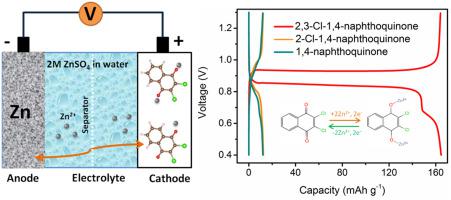Journal of Power Sources ( IF 8.1 ) Pub Date : 2020-11-17 , DOI: 10.1016/j.jpowsour.2020.229114 Jianbo Wu , Wei Xu , Yan Lin , Xin Shi , Fan Yang , Xihong Lu

|
Quinone molecular for Zn ion storage typically undergo unsatisfactory capacity and low output voltage because of their poor redox activity of carbonyl group and low redox potential. Here, we demonstrate an energetic strategy to remarkably improve the Zn ion storage capability of 1,4-naphthoquinone by rationally modulating the electronic structure via functional group substitution. The dichloro substituted 1,4-naphthoquinone cathode delivers a high capacity (164.5 mAh g−1 at 0.2 A g−1) and a voltage elevation of 50 mV compared to pristine 1,4-naphthoquinone cathode (12 mAh g−1). Experimental results and density functional theory studies consistently reveal that the introduction of electron-withdrawing Cl substituent can effectively manipulate the electron density of carbonyl carbon and molecular orbital energy levels of 1,4-naphthoquinone, endowing it with higher redox reactivity and discharge plateau. The capability to modulate the electron structure of the quinone cathode by molecular-level designing can provide valuable insights for the development of high-performance zinc battery cathode.
中文翻译:

调谐电子结构赋予1,4-萘醌显着增强的Zn离子存储能力和输出电压
由于其羰基的氧化还原活性差和氧化还原电势低,用于锌离子存储的醌分子通常不能令人满意的容量和低输出电压。在这里,我们展示了一种通过合理地通过官能团取代来调节电子结构的策略,以显着提高1,4-萘醌的Zn离子存储能力。与原始的1,4-萘醌阴极(12 mAh g -1)相比,二氯取代的1,4-萘醌阴极提供了高容量(0.2 A g -1时为164.5 mAh g -1),电压升高了50 mV。)。实验结果和密度泛函理论研究一致表明,吸电子Cl取代基的引入可以有效地控制羰基碳的电子密度和1,4-萘醌的分子轨道能级,使其具有更高的氧化还原反应性和放电平稳性。通过分子水平设计调节醌阴极电子结构的能力可以为开发高性能锌电池阴极提供有价值的见解。











































 京公网安备 11010802027423号
京公网安备 11010802027423号